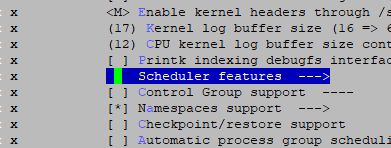
jgauthier
Members-
Posts
62 -
Joined
-
Last visited
Recent Profile Visitors
The recent visitors block is disabled and is not being shown to other users.
-
I wanted to come around to this. Wireless works fine. The problem is the guy between the chair and the keyboard. In the past I've been able to at least scan wifi networks without an antenna. I cannot on this board. I attached the antenna and I was able to see all the networks. oof
-
5) Control a flight vehicle with real time input and outputs. [jgauthier@gamma build]$ diff -u config/kernel/linux-sunxi64-edge.config userpatches/linux-sunxi64-edge.config [jgauthier@gamma build]$ I'm not sure why it's expected that those would be different. I made the configuration with 'make menuconfig' and then copied to to userpatches. I did this because, at the time, I thought it was being overwritten. It was, but that was due to armbian-kernel.sh.
-
@going I can, yes. But at the moment I don't want to distract from the wifi issue I am trying to solve. I am building a test application that must perform real time operations. I have previously done this with other ARM boards/distributions, but for this small project I am trying to go with "simplicity" (nothing is ever simple) I can provide the 'duff -u' for your interest, but I don't know what you want me to compare it against. i have linux-sunxi64-edge.config in my userpatches/ folder. It's generated from make menuconfig, and then I removed 'CGROUP_SCHED' from armbian-kernel.sh. Real-time applications work fine now. (They do not with group scheduling) root:~/# ./cyclictest --mlockall --smp --priority=80 --interval=200 --distance=0 # /dev/cpu_dma_latency set to 0us policy: fifo: loadavg: 0.30 0.37 0.17 2/200 1471 T: 0 ( 1468) P:80 I:200 C: 379209 Min: 7 Act: 18 Avg: 10 Max: 83 T: 1 ( 1469) P:80 I:200 C: 379008 Min: 6 Act: 19 Avg: 10 Max: 68 T: 2 ( 1470) P:80 I:200 C: 378802 Min: 7 Act: 19 Avg: 10 Max: 79 T: 3 ( 1471) P:80 I:200 C: 378595 Min: 7 Act: 20 Avg: 10 Max: 75
-
Thank you for your response. I pulled down one of the "Standard Support" images. I enabled the overlay, and brought the interface up, but scanning does not return anything: root@bananapim4zero:~# iw dev wlan0 scan root@bananapim4zero:~# I wanted a 6.12 kernel that had real time extensions built in. I didn't realize 'current' would handle that. I will end up replacing this with a current kernel. I can't remember how anything < 6.12 handles real time patches. Maybe Armbian does it automatically as part of its patch set.
-
Greetings, I've built a custom image for the BPI M4 Zero and have been using a wired USB cable for my config and development work, It's final destination will require wireless. So I started to configure that today and discovered that it does not find any wireless access points. The device exists. 3: wlan0: <NO-CARRIER,BROADCAST,MULTICAST,UP> mtu 1500 qdisc pfifo_fast state DOWN group default qlen 1000 link/ether ac:6a:a3:3f:9c:65 brd ff:ff:ff:ff:ff:ff There is an overlay loaded (I did not add it, it was part of the image build) overlays=bananapi-m4-sdio-wifi-bt usbhost bananapi-m4-pi-5-6-i2c0 bananapi-m4-pi-7-8-i2c1 I do not see any errors from dmesg, but only these: [ 8.484857] brcmfmac: brcmf_fw_alloc_request: using brcm/brcmfmac43455-sdio for chip BCM4345/6 [ 8.851537] brcmfmac: brcmf_c_process_txcap_blob: no txcap_blob available (err=-2) [ 8.852261] brcmfmac: brcmf_c_preinit_dcmds: Firmware: BCM4345/6 wl0: Aug 29 2023 01:47:08 version 7.45.265 (28bca26 CY) FWID 01-b677b91b I am not sure where to begin diagnosing this. I almost never use wireless on Linux so I could be overlooking something basic. # iwlist wlan0 scanning wlan0 No scan results # uname -a Linux bananapim4zero 6.13.11-edge-sunxi64 #5 SMP PREEMPT_RT Thu Apr 10 12:42:07 UTC 2025 aarch64 GNU/Linux
-
Understood. Thank you. When I follow that procedure, config settings are set to "Y" after I've explicitly set them to "N". After doing a kernel-config [🐳|🌱] Exporting new kernel defconfig [ /armbian/output/config/linux-sunxi64-edge.config ] [🐳|🔨] 'defconfig' -> '/armbian/output/config/linux-sunxi64-edge.config' [🐳|🌱] Exporting new kernel config - git commit pending [ /armbian/userpatches/linux-sunxi64-edge.config ] [🐳|🔨] 'defconfig' -> '/armbian/userpatches/linux-sunxi64-edge.config' $ cat output/config/linux-sunxi64-edge.config | grep CGROUP [no output] $ diff output/config/linux-sunxi64-edge.config userpatches/linux-sunxi64-edge.config [no output] Then I build the kernel, install it, and on the board: zcat /proc/config.gz |grep CGROUP_SC CONFIG_CGROUP_SCHED=y After reviewing the kernel build output: less -RS output/logs/log-kernel-7c3cd346-d31c-4166-9dc2-4f5c9c641554.log.ans --> (13) COMMAND: ./scripts/config --enable CGROUP_BPF --> (13) COMMAND: ./scripts/config --enable CGROUP_CPUACCT --> (13) COMMAND: ./scripts/config --enable CGROUP_DEVICE --> (13) COMMAND: ./scripts/config --enable CGROUP_FREEZER --> (14) COMMAND: ./scripts/config --enable CGROUP_HUGETLB --> (14) COMMAND: ./scripts/config --enable CGROUP_NET_CLASSID --> (14) COMMAND: ./scripts/config --enable CGROUP_NET_PRIO --> (14) COMMAND: ./scripts/config --enable CGROUP_PERF --> (14) COMMAND: ./scripts/config --enable CGROUP_PIDS --> (14) COMMAND: ./scripts/config --enable CGROUP_SCHED --> (14) COMMAND: ./scripts/config --enable CGROUPS Something has enabled everything I said I wanted disabled. When configuring the kernel subsequent times, these items are enabled again as well.
-
1) What is the correct way to make kernel configuration changes? I have attempted to: ./compile.sh BOARD=bananapim4zero BRANCH=edge kernel-config saved config,. and then ./compile.sh BOARD=bananapim4zero BRANCH=edge kernel However,after installing the kernel I found the config changes were not applied. I then reran: ./compile.sh BOARD=bananapim4zero BRANCH=edge kernel-config and I see that the config changes I made have been reverted. 2) How to clean the kernel and force a rebuild? I tried ./compile.sh BOARD=bananapim4zero BRANCH=edge CLEAN_LEVEL="make-kernel" kernel But the kernel was not cleaned, nor rebuilt. Thank you!
-
@going Thanks for your process. Making all of the changes and putting the config into userpatches is what worked.
-
I think my issue is actually that CONFIG_RT_GROUP_SCHED is enabled. I was certain I had disabled it. After some sluething.. It turns out I don't know how to configure/build a kernel. I run ./compile.sh BOARD=bananapim4zero BRANCH=edge kernel-config I then make some changes and tell it to save: For instance when I enter menuconfig, I see this. I then REMOVE the check. I say YES OOPS. I realized I wanted to make another change. And now it's back. After unchecking this, and building the kernel, moving the kernel, installing, and rebooting I see the config hasn't change on board. So, I must have a misunderstanding of how this is supposed to work. I checked here: https://docs.armbian.com/Developer-Guide_Build-Commands/ Which says "Add or Remove" modules, but doesn't elaborate if it's copying some defaults or where they might be coming from.
-
I'm hesitant to post this here, because I am not really sure that this is an armbian issue to begin with. But I'm somewhat stumped. During the build process I configured the kernel to enable real time threads. CONFIG_NO_HZ_COMMON=y CONFIG_HZ_1000=y CONFIG_HZ=1000 CONFIG_PREEMPT_RT=y However, as I started to migrate my development I discovered I couldn't create a real time thread. So I pulled down areal time test suite (https://wiki.linuxfoundation.org/realtime/documentation/howto/tools/rt-tests) And confirmed it has the same issue: Unable to change scheduling policy! either run as root or join realtime group I am root, it is a real time kernel. Linux bananapim4zero 6.13.7-edge-sunxi64 #1 SMP PREEMPT_RT Thu Mar 13 12:08:08 UTC 2025 aarch64 GNU/Linux I am not sure what might be driving this. For the past several months I've been doing some dev work on a TI AM625 based board that I built a yocto distribution on and it's fine. I know that is a completely different board, but my kernel setting for real time enablement are the same. I pulled them from that build since. Appreciate any input!
-
Good news! I'm dumb! iperf defaults to a 1M transfer rate over UDP. Easily changed with -b option.
-
Hello, I am using a NanoPi Duo2 with Armbian 22.11 and Kernel 5,15,80. This device uses an AP6216 wireless interface, which I have noticed are pretty common on sunxi based boards. I ran some bandwidth tests and had pretty poor results: [ ID] Interval Transfer Bandwidth [ 3] 0.0000-1.0000 sec 129 KBytes 1.05 Mbits/sec [ 3] 1.0000-2.0000 sec 129 KBytes 1.05 Mbits/sec [ 3] 2.0000-3.0000 sec 127 KBytes 1.04 Mbits/sec [ 3] 3.0000-4.0000 sec 129 KBytes 1.05 Mbits/sec [ 3] 4.0000-5.0000 sec 129 KBytes 1.05 Mbits/sec [ 3] 5.0000-6.0000 sec 127 KBytes 1.04 Mbits/sec [ 3] 6.0000-7.0000 sec 129 KBytes 1.05 Mbits/sec [ 3] 7.0000-8.0000 sec 127 KBytes 1.04 Mbits/sec [ 3] 8.0000-9.0000 sec 129 KBytes 1.05 Mbits/sec [ 3] 9.0000-10.0000 sec 129 KBytes 1.05 Mbits/sec Not sure if the issue was the driver, hardware, or otherwise I connected a USB wifi dongle and disabled the AP6216. I've tested with the same results again: [ ID] Interval Transfer Bandwidth [ 3] 0.0000-1.0000 sec 129 KBytes 1.05 Mbits/sec [ 3] 1.0000-2.0000 sec 129 KBytes 1.05 Mbits/sec [ 3] 2.0000-3.0000 sec 127 KBytes 1.04 Mbits/sec [ 3] 3.0000-4.0000 sec 129 KBytes 1.05 Mbits/sec [ 3] 4.0000-5.0000 sec 129 KBytes 1.05 Mbits/sec [ 3] 5.0000-6.0000 sec 127 KBytes 1.04 Mbits/sec [ 3] 6.0000-7.0000 sec 129 KBytes 1.05 Mbits/sec [ 3] 7.0000-8.0000 sec 127 KBytes 1.04 Mbits/sec [ 3] 8.0000-9.0000 sec 129 KBytes 1.05 Mbits/sec [ 3] 9.0000-10.0000 sec 129 KBytes 1.05 Mbits/sec [ 3] 0.0000-10.0191 sec 1.25 MBytes 1.05 Mbits/sec It's my suspicion that the issue is now elsewhere - but where? I have no idea. Thanks for any ideas.




